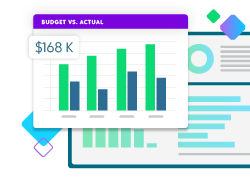Making a Case for Calculating Your Nonprofit’s Indirect Costs

If the 500-piece puzzle you are working on only has 475 pieces, you would not only have gaps in the final picture, but it would also be incredibly frustrating to put together.
Creating your nonprofit budget and funding requests without including your indirect costs is like putting together a puzzle and not having all the pieces. Nonprofits can use indirect costs to help illustrate the total cost of a program, budget for new ventures, and communicate the need for funding entire programs rather than just the direct programmatic expenses.
After all, you need people and places to offer programs—it would be challenging for a nonprofit arts organization to have a pottery class without a studio and instructor.
Understanding Indirect Costs for Nonprofits
Indirect costs, often misclassified as “overhead,” are expenses associated with managing programs but not directly tied to a single program. Indirect costs are classified as General and Administrative (G&A) expenditures that help provide a service and include things such as accounting, legal, insurance, bank fees, licenses, and other expenses required for the overall operation of an entity, such as administrative professionals or human resources expenses.
Nonprofit organizations do not frequently use indirect costs unless they pursue government grants, but an indirect cost rate can be helpful to all organizations. Calculating indirect costs for nonprofit programs can be daunting because organizations often produce social and public goods, not tangible items. But once you understand your indirect cost rate, applying it to your budget and funding requests is simple.
A For-Profit Example of Indirect Costs
The simplest way to understand indirect costs is through a for-profit lens. Here is an example.
Connie is creating a cookie company and plans to use her secret family recipes to build Connie’s Cookies into the next big name in desserts. Connie’s recipes call for flour, sugar, butter, and a few secret ingredients passed down from her grandma. Connie can calculate the amount of each ingredient and knows the direct cost (i.e., ingredient costs) for each batch of cookies. However, she also has indirect costs she needs to account for, including her bakery (rent, utilities), equipment (ovens, mixers, baking sheets), and administrative fees (accounting, marketing).
So, Connie’s Cookies has a direct cost of $12/dozen for its cookies and based on sales projections, and it can pass along the indirect costs (general and administrative) to each batch at $6/dozen. If Connie wants to grow her cookie empire, she will need to charge a minimum of $18/dozen to break even (total cost), rather than $12/dozen (direct cost).
| Direct Costs | Indirect Costs |
|---|---|
| Flour | Facility |
| Sugar | Equipment |
| Butter | Administration |
- Total direct costs: $12 per dozen
- Total indirect costs: $6 per dozen
- For growth, Connie should charge at least: $18/dozen
Applying Indirect Costs for Nonprofits
In the Connie’s Cookies example, using indirect costs helped determine the total “breakeven” cost for cookie production; however, it is a little more complicated within a nonprofit context. Indirect costs cannot simply be passed onto the consumer like in a for-profit—especially for social services or other organizations where the client is not paying for the service.
If the cost of flour increases, then Connie may simply be able to raise the price of a cookie from $2 to $2.50. If she needs more funding to pay her baking assistants, she could raise prices to $3 per cookie. A nonprofit operating a soup kitchen is not so lucky. Those paying for the service (foundations, corporations, individual donors, government contracts) are not those receiving the service (individuals experiencing homelessness or food insecurity).
Calculating indirect costs is helpful for various reasons, ranging from budgeting to fundraising. Here are three reasons an organization should consider calculating its indirect cost rate.
Indirect Costs Equitably Distribute Operating Expenses
Indirect costs help nonprofits calculate the total costs of programs, and while there are different allocation methods, most illustrate the full costs of offering a program. This helps ensure that all programs and services are covering their fair share of the organization’s costs. Calculating an indirect cost rate and applying it to direct program costs can help organizations identify where they may need to raise additional funding, cut costs, or include more right-sized requests in grant proposals.
Indirect Costs Are Industry Best Practice for Allocating “Overhead”
Some funders focus on funding projects first and not covering “overhead” (i.e., important costs to delivering an effective program), which results in a nonprofit accounting shell game to figure out who is paying for what and which grant is being charged for which part of the project. (Sidenote to funders: it all goes in the same bucket, so it’s easier for everyone involved if you plan to support the total cost.)
Incorporating indirect costs can make allocating operating costs to programs easier by using industry best practices in allocating operations to programs. Whenever an organization can, it should include indirect costs in grant budgets. Many funders will not pick apart a budget. If funders have questions, use one of the responses below to explain the purpose of the indirect cost:
- “Indirect costs support the infrastructure that makes our programs successful, and without our internal support, we would not be able to offer impactful programs.”
- “Indirect costs are our way of equitably passing along organizational expenses to all programs to ensure that each component of our operations is financially covered and that we raise the proper funding for each program and service we offer.”
- “Our organization uses an indirect cost rate of 18% for all programs to equally distribute administrative costs such as staff support, occupancy, utilities, and insurance. These are necessary expenses to facilitate a successful project.”
TIP: If funders do not allow the organization to include indirect costs, you may put it in your budget as “matching funds” if the organization must cover that independent of the grant. Just because a funder does not pay for it does not mean it is not a reasonable expense.
Indirect Costs Help Quickly Estimate Proposed Program Costs
If an organization calculates its indirect cost rate, it can use it as a budgeting tool for estimating how new programs could impact the organization’s bottom line. For example, if you know your organization has a 15% indirect cost and you are working on a new program that’s expected to cost $100,000, you know it will also require $15,000 in indirect costs to cover additional operating costs associated with starting, operating, and evaluating the new program.
Indirect costs are calculated annually, but they often do not fluctuate from year to year in an extreme way; therefore, using the indirect rate can help organization leadership and board members understand the total amount that needs to be generated to expand.
Begin Your Indirect Cost Conversations Today
There are still a lot of misconceptions about operating costs and how much (or how little) to include on your balance sheet. But if you want to create a stable financial organization, you need to start talking with your organizational leadership today.
Want to learn more about how to change the conversation about indirect costs at your organization? Check out the white paper, Accounting for the Full Cost of Impactful Programs: Calculating Indirect Costs for Your Nonprofit.
Fund Accounting Software that Drives Impact
Find out how Blackbaud’s Financial Edge NXT® fits your organization.




